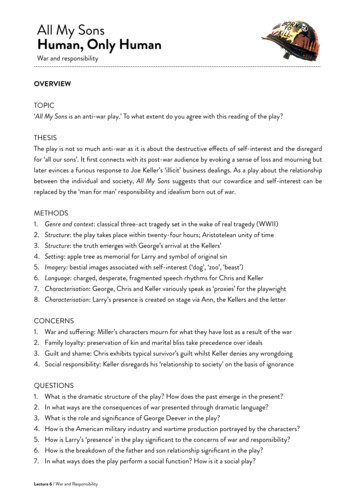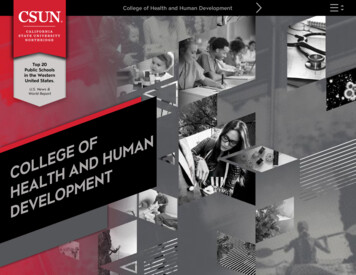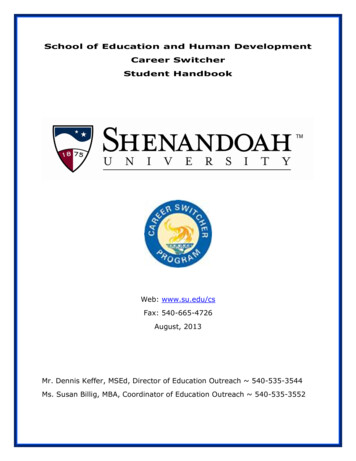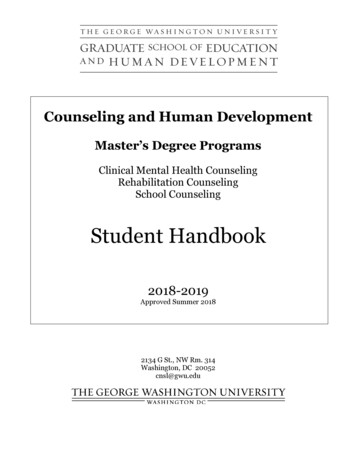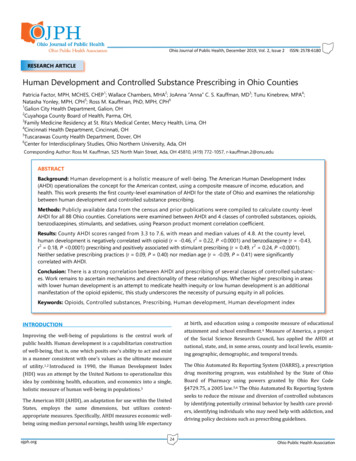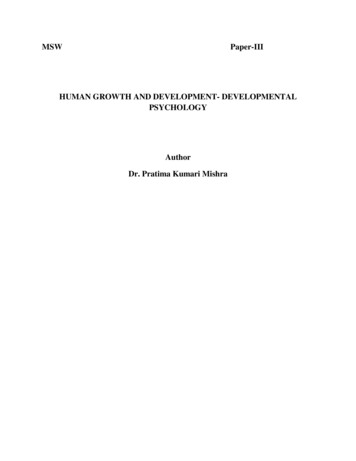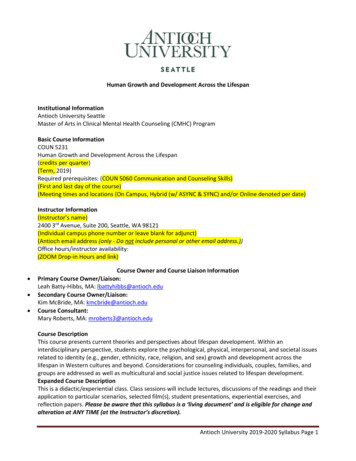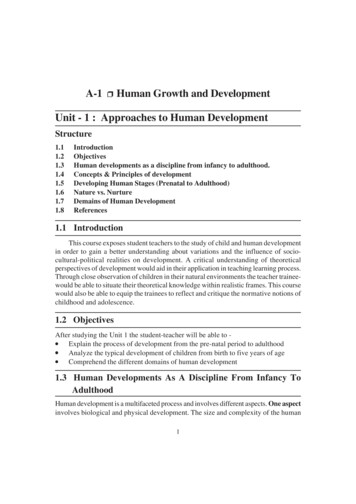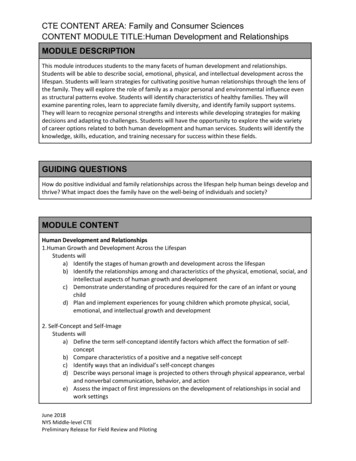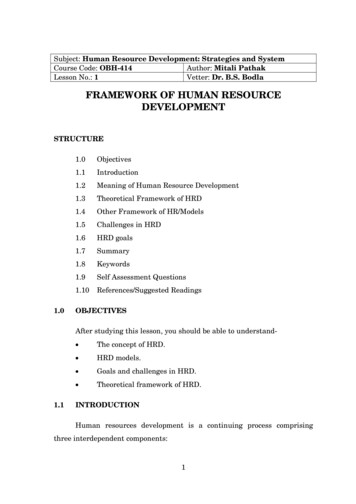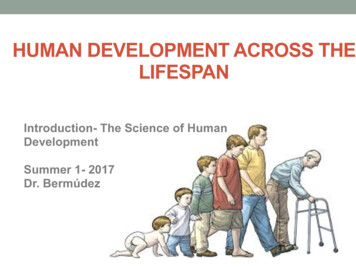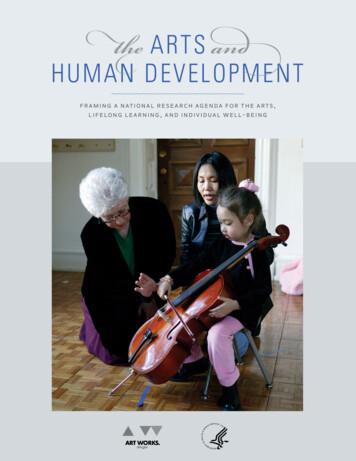
Transcription
the ARTS andHUMAN DEVELOPMENTFraming a National Research Agenda for the Arts,Lifelong Learning, and Individual Well-Being
the ARTS andHUMAN DEVELOPMENTFraming a National Research Agenda for the Arts,Lifelong Learning, and Individual Well-BeingA white paper based on “The Arts and Human Development:Learning across the Lifespan,” a convening bythe National Endowment for the Arts in partnership withthe U.S. Department of Health and Human Services,March 14, 2011, Washington, DC
November 2011National Endowment for the Arts1100 Pennsylvania Avenue, NWWashington, DC 20506-0001Telephone: 202-682-5400Prepared for the NEA Office of Research & Analysis by the National Center for Creative Aging.Lead author: Gay Hanna. Co-authors: Michael Patterson, Judy Rollins, and Andrea Sherman.Produced by the NEA Office of Research & AnalysisSunil Iyengar, DirectorPatricia Moore Shaffer, Senior Evaluation OfficerEllen Grantham, Program AnalystEditorial and publication assistance by Don Ball and Rebecca GrossDesigned by Beth Schlenoff DesignThe Office of Research & Analysis wishes to thank Sharon Ramey, Virginia Tech Carilion ResearchInstitute, for her editorial contributions.Front Cover Photo: The Suzuki Cello program at the Settlement Music School, Philadelphia,Pennsylvania. Photo by the Settlement Music School.Creativity sidebar: MRI, Photo by iStock.Settlement Music School sidebar: Children participating in the Kaleidoscope Pre-School ArtsEnrichment Program at the Settlement Music School, Philadelphia, Pennsylvania. Photo by theSettlement Music School.Chicago Arts Partnerships in Education sidebar: Chicago students participate in a music educationprogram facilitated by the Chicago Arts Partnerships in Education, Illinois. Photo by the Chicago ArtsPartnerships in Education.Alzheimer’s Poetry Project sidebar: Seniors participating in the Alzheimer’s Poetry Project, Sante Fe,New Mexico. Photo by Margaret Victor.Printed in the United States of America.Library of Congress Cataloging-in-Publication DataThe arts and human development : framing a national research agenda forthe arts, lifelong learning, and individual well-being.p. cm.A white paper based on The arts and human development : learning acrossthe lifespan, a convening by the National Endowment for the Arts inpartnership with the U.S. Department of Health & Human Services, March14, 2011, Washington, D.C.1. Arts--United States--Citizen participation. 2. Arts surveys--UnitedStates. 3. Arts and society--United States. I. National Endowment forthe Arts. II. United States. Dept. of Health and Human Services. III.Title: Framing a national research agenda for the arts, lifelonglearning, and individual well-being.NX230.A78 2011700.1’03--dc232011038723202-682-5496 Voice/TTY(a device for individuals who are deaf or hearing-impaired)Individuals who do not use conventional print materials may contact the Arts Endowment’s Officefor AccessAbility at 202-682-5532 to obtain this publication in an alternate format.This publication is available free of charge at arts.gov, the website of the National Endowment forthe Arts.
leads to deeper collaboration inresearch and in identifying new ways to engagethe arts to improve people’s lives.” kathleen sebeliusSecretary, U.S. Department of Health & Human Services“How do the artshelp build us as a people and as individuals? We sharea fundamental mission — how to improve the qualityof life. The arts are central to human development.”Rocco LandesmanChairman, the National Endowment for the ArtsFrom opening remarks at “The Arts and Human Development: Learning across the Lifespan,” a conveningby the National Endowment for the Arts in partnership with the U.S. Department of Health & HumanServices, March 14, 2011, Washington, DC
TABLE OF CONTENTS7Executive Summary12Chapter 1. Introduction151517Chapter 2. The Arts in Early Childhood191922Chapter 3. The Arts in Youth and Adolescence242427Chapter 4. The Arts and Older Adults293031Chapter 5. Recommendations and Conclusions33ReferencesEvidence-based ClaimsLooking to the FutureEvidence-based ClaimsLooking to the FutureEvidence-based ClaimsLooking to the FutureRecommendationsConclusionthe arts and human development5
EXECUTIVE SUMMARYOverviewHuman development describes a complex web of factors affecting the health and well-being of individualsacross the lifespan. Together, these factors yield cognitive and behavioral outcomes that can shape the socialand economic circumstances of individuals, their levelsof creativity and productivity, and overall quality of life.Increasingly in the 21st century, U.S. policy leaders inhealth and education have recognized a need for strategies and interventions to address “the whole person.”They have urged a more integrated approach to policydevelopment—one that can reach Americans at variousstages of their lives, across generations, and in multiplelearning contexts.The arts are ideally suited to promote this integratedapproach. In study after study, arts participation andarts education have been associated with improvedcognitive, social, and behavioral outcomes in individuals across the lifespan: in early childhood, in adolescenceand young adulthood, and in later years. The studiesinclude:n Neuroscience research showing strong connectionsbetween arts learning and improved cognitivedevelopment;n Small comparison group studies revealing the arts’contributions to school-readiness in early childhood;n Longitudinal data analyses demonstrating positiveacademic and social outcomes for at-risk teenagerswho receive arts education; andn S everal studies reporting improvements in cognitivefunction and self-reported quality of life for olderadults who engage in the arts and creative activities,compared to those who do not.This emerging body of evidence appears to support aneed for greater integration of arts activities into healthand educational programs for children, youth, and olderadults. Yet further research is necessary so that policymakers and practitioners can understand the pathwaysand processes by which the arts affect human development, thereby enhancing the efficacy of arts-based practices in optimizing health and educational outcomes forAmericans of all ages.NEA-HHS CollaborationOn March 14, 2011, the National Endowment for theArts (NEA) in partnership with the U.S. Department ofHealth and Human Services (HHS) hosted a conveningin Washington, DC to showcase some of the nation’smost compelling studies and evidence-based programsthat have identified cognitive, social, and behavioraloutcomes from arts interventions.HHS Secretary Kathleen Sebelius and NEA ChairmanRocco Landesman gave keynote speeches, followed bysenior officials representing the HHS Administrationfor Children and Families (ACF) and Administrationon Aging (AoA). Representatives from the National Institutes of Health (NIH) and the Health Resources andServices Administration (HRSA) also participated. TheNEA Office of Research & Analysis organized the event.the arts and human development7
Secretary Sebelius declared a mutual goal for the convening agencies: “We hope this meeting leads to deepercollaboration in research and in identifying new waysto engage the arts to improve people’s lives.” Similarly,Chairman Landesman asked: “How do the arts helpbuild us as a people and as individuals?” The NEA andHHS, he said, “share a fundamental mission—how toimprove the quality of life.”The resulting white paper proposes a framework forlong-term collaboration among the NEA, HHS, and other federal agencies to build capacity for future researchand evidence-sharing about the arts’ role in humandevelopment. A worthy aim of that collaboration is tofoster data-driven models for including the arts in policies and programs that seek to improve the well-beingof Americans at different stages of their lives.n C hildren attending a preschool that used an arts in-tegration model made greater developmental stridesin multiple domains, including initiative, socialrelations, creative representation, music and movement, language, literacy, and logic and mathematics,compared to children in a regular Head Start program(Social Dynamics, LLC 2005).Youth and Adolescencen A rts-engaged low-income students were more likelythan their non-arts-engaged peers to attend and dowell in college, obtain employment, volunteer in theircommunities, and participate in the political processby voting. Study findings suggest that arts-engagedlow-income students performed similarly to averagehigher-income students (Catterall 2009).n S tudent behavior, measured by numbers of suspen-Key Research FindingsStudies reported at the convening and elsewhere havemeasured cognitive, social, and behavioral developmentamong arts participants and arts learners. The researchapplies to three pivotal sections of the lifespan:Early Childhoodn Three- to five-year-olds from low socioeconomic status(SES) families demonstrated significant gains in nonverbal IQ, numeracy, and spatial cognition after theyhad received music training and attention trainingin a small-class setting—compared to a regular HeadStart control group (Neville, et al. 2008).n Students from low-income backgrounds who at-tended an “arts enrichment” preschool improvedin school-readiness skills, more so after two yearsthan after one year of program attendance. Childrenfrom diverse racial and ethnic backgrounds benefitedequally. In a related study by the same research team,students attending the arts enrichment preschoolshowed higher levels of language development (measured by “receptive vocabulary”) than did studentswho attended a comparison preschool (Brown, Benedett, & Armistead 2010).8national endowment for the artssions and discipline referrals, improved in schoolsinvolved in an arts integration initiative, as didstudent attendance. Student academic achievementalso improved: seventh-grade students in treatmentschools significantly outperformed control-groupstudents on state standardized tests in reading andmath (Pittsburgh Public Schools ca. 2008).n S tudents involved in after-school activities at artsorganizations demonstrated greater use of complexlanguage than did their peers. Students who wereinvolved in arts education for at least nine hours aweek were four times more likely than their peersnationally to have won school-wide recognition fortheir academic achievement and three times morelikely to have won an award for school attendance(Heath 1999).Older Adultsn O lder adults participating in a chorale programreported higher overall physical health, fewer doctorvisits, less medication use, fewer instances of falls,and fewer health problems when compared to a control group. The chorale group also displayed evidenceof higher morale and less loneliness than did thecontrol group (Cohen, et al. 2006).
n Older adults participating in a structured theatricalintervention over four weeks significantly improved,compared to two control groups (a singing group anda no-treatment control group) in four cognitive measures: immediate word recall, problem-solving, verbalfluency, and delayed recall (Noice & Noice 2009).n Older adults with Alzheimer’s disease and those withrelated dementias who participated in a creativestorytelling intervention became more engaged andmore alert than those in a control group. There weremore frequent staff-resident interactions, peer socialinteractions, and social engagement in facilities usingthe creative storytelling intervention than in controlgroup facilities (Fritsch, et al. 2009).Challenges and OpportunitiesAlthough these findings are promising, conveningparticipants agreed that a collective leap forward is necessary to a) replicate, extend, and bring such studies toscale and b) share the results with researchers, practitioners, and the general public. In particular, the followingchallenges remain:n A lack of coordination among federal agency depart-ments and investigators and practitioners fromvarious disciplines (e.g., arts education, child development, medicine, nursing, educational psychology,cognitive neuroscience, the behavioral and socialsciences) in pursuing a vigorous research agenda tounderstand the role of arts and arts education inhuman development.n Th e small size of study populations participating inresearch on the arts and human development currently limits generalizability of the results. So far,the majority of reported studies rely on correlationaldata, rather than results from well-controlled trials.Another limiting factor is the dearth of longitudinalstudies.n L ow visibility of research findings, program evaluationdata, and evidence-based models integrating the artsin health and educational programs provided at various segments of the lifespan.These needs have acquired greater currency in light ofrecent demographic trends and domestic policy priorities. With a rising cohort of highly active baby-boomersfacing retirement, opportunities for creative engagement and lifelong learning in the arts are likely to provecritical for improved health and well-being. Educatorsand communities, confronted with large percentagesof Americans failing to finish high school, are seekinginnovative and effective strategies to engage studentsand boost their achievement levels. In this climate, astronger role for arts education should be investigated.Finally, the high-order critical thinking and creativityskills that have been linked to arts training are deemedincreasingly vital to today’s workforce, the U.S. economy, and our nation’s overall competitiveness. At theconvening, Mary Wright, a program director with theConference Board, asserted: “Creativity and innovationare going to increase in importance.”Wright based her conclusion on recent industry surveys of employers’ hiring needs. The results are clear:U.S. companies stand to gain from the knowledge andskills that an arts education can provide. High demandamong employers for creativity, innovation, and criticalthinking will translate into positive social and economicoutcomes for workers who possess those skills, thus contributing more broadly to their human development.RecommendationsThe moment is ripe for federal leadership in the design,conduct, and dissemination of rigorous research andevidence-based practices documenting the arts’ contributions to human development—from early childhood,adolescence, and young adulthood to middle-aged andolder adults.To support this leadership role, the following actionsare recommended:1. Establish a federal interagency task force topromote the regular sharing of research and information about the arts and human development.The task force would include high-level officials from theNational Endowment for the Arts, the Department ofEducation, and HHS agencies such as the Administrationthe arts and human development9
for Children and Families, the Administration on Aging,and the National Institutes of Health. The group wouldconvene two to three times a year to review progress onthe following tasks:n W hat are appropriate outcomes (including quality-of-n H ost a series of webinars highlighting examples ofn H ow might successful randomization be achieved andcompelling research and evidence-based practicesthat have integrated the arts in human development.The webinars will be available to the public, but aimedespecially at researchers and providers of the arts,health, and education for various segments of thelifespan.n C oordinate the distribution of information about fund-ing opportunities for researchers and providers of thearts, health, and education across the lifespan.n C onduct or commission an inventory and gap analysis offederally sponsored research on the arts and humandevelopment so that future research opportunitiescan be developed by and across agencies, departments, and the private sector.n D evelop an online clearinghouse of research andevidence-based practices that examine or utilize thearts in health and educational programs across thelifespan.2. Convene a series of technical workshops to helpdevelop research proposals that represent robustand innovative study design methods to investigate therelationship between the arts and human development.If the most competitive research proposals are to reachthe appropriate funders, both public and private, thencapacity-building through peer learning must occur. Aseries of workshops would help to improve the overallrigor of such studies, by recruiting outstanding scientists to tackle vexing and complex problems in pursuingthis topic.Because of formidable difficulties involved in mountinglarge-scale, longitudinal studies of the arts at work inhuman development—and because of the complexityof study design factors related to different age populations—it is important to bring together researchmethodologists and content experts in neuroscience,health, education, and the arts to advance discussion ofkey topics, including:10national endowment for the artslife indicators) for studies comparing arts interventions with control groups in the provision of healthand/or educational services?comparison research designs developed for exploringthe arts’ potential impact, particularly on childrenand older adults?n H ow can diversity in the study populations be promotedto ensure that findings about the arts and humandevelopment will apply toward and thus potentiallybenefit all groups (i.e., individuals from all ages andracial/ethnic backgrounds, including those with disabilities)?n H ow can artists and arts educators contribute fully tothe planning and conduct of research? What protocols and criteria should guide the administration ofarts content and delivery?3. Bring the arts to national and internationalconversations about integrating the concept ofwell-being into policy development.Even while new evidence is being gathered, the federalpartnership should leverage growing national andinternational interest in using measures of subjective well-being as complementary and valuable toolsto guide policy decisions. This discussion is highlyconsistent with the HHS strategic goal—“Advance thehealth, safety, and well-being of the American people.”At the same time, greater analysis of the arts in directrelationship to well-being will provide the NEA with anopportunity to realize one of its own strategic goals forthe American people—“Promote public knowledge andunderstanding about the contributions of the arts.”This recommendation also aligns with two NationalInstitute on Aging-sponsored efforts to advance themeasurement of subjective well-being for application toresearch on aging and health. Those efforts include:n D evelopment of a National Research Council panel on“measuring subjective well-being in a policy-relevantframework.” This initiative, co-sponsored by the UKEconomic and Social Research Council, was singledout by the White House in a May 25, 2011, joint
fact sheet as having “the potential to generate newinsights that will directly inform social and economicpolicies.”n A series of National Academies workshops that willconclude in September 2012 with recommendationson the “evaluation of measures of subjective wellbeing and development of OECD (Organisation forEconomic Co-operation and Development) guidancefor national statistical agencies on the measurementof well-being.” The workshops should be monitoredfor their potential applicability to future federal datacollection about the arts’ role in human development.Ultimately, it may surprise no one to discover thatarts and arts education have strong positive effects onwellness and quality of life. Throughout human history,in virtually all cultures, the arts have been viewed as ahallmark of civilization—so why not of health and human development?Yet one thing is certain: without vigorous and extensive research and evidence-sharing among governmentagencies, scientists, practitioners, and the general public, our nation will continue to lack effective, replicablemodels for using the arts to improve quality-of-life outcomes. The resulting deficiency represents a substantialloss for arts, health, and education providers servingAmericans at all stages of life. The NEA-HHS partnership, through this white paper, endorses the timelinessand potential cost-effectiveness of the proposed collaborations and research endeavors.the arts and human development11
chapter1INTRODUCTIONIncreasingly in the 21st century, U.S. policyleaders in health and education have recognized a needfor strategies and interventions to address the development of the “whole person.” They have urged a more integrated approach to policy development—one that canreach Americans at various stages of their lives, acrossgenerations, and in multiple learning contexts. Therecent surge of interest in measurements of happinessand subjective well-being also reflects a growing desireto assess multiple dimensions of human development.1Participation in the arts and arts learning has long beenbelieved to support the development of human potential. Harvard psychologist Howard Gardner, in his 1983book, Frames of Mind, proposed that we as individualshave multiple intelligences. These ways of knowing areinfluenced by a preferred sensory modality: one personmay learn and develop better through listening or auditory experiences, whereas another may need to learnkinesthetically or visually or use multimodal learning.Involvement in the arts and arts learning increases anindividual’s exposure to multiple ways of experiencingthe world, and, in so doing, increases the potential forhuman development.Over the past two decades, landmark studies haveassociated arts participation and arts education withcognitive, social, and behavioral advantages in individuals across the lifespan: in early childhood, in adolescenceand young adulthood, and in later years. For example,some studies have linked the arts to school-readiness,academic achievement, and lower risks of juvenile delinquency. Other studies, concerning the latter part oflife, have shown that arts engagement and arts learning12national endowment for the artshave the potential to reduce the need for medication,reduce falls by improving gait and balance, and improvebrain fitness. A sample of these studies are summarizedin the chapters that follow.Until quite recently, it was not clearly understood howthe arts contribute to these outcomes. Research inthe field of cognitive neuroscience has begun to makesignificant strides in this area. In his keynote address atthe March 14, 2011, NEA-HHS event, Dr. Michael Gazzaniga, a nationally renowned cognitive neuroscientist,recounted the significant Dana Foundation-supportedLearning, Arts, and the Brain research initiative. Theeffort united cognitive neuroscientists from sevenuniversities across North America “to grapple with thequestion of why arts training has been associated withhigher academic performance.”2 One critical mechanismthat might explain enhanced cognition, he said, is exercise of the brain’s attentional network:We know that the brain has a system of neuropathways dedicated for attention . We knowthat training these attention networks improvesgeneral measures of intelligence. We can be fairlysure that focusing our attention on learning andperforming an art, if we practice frequently andare truly engaged, activates these same attentionalnetworks. We, therefore, would expect focusedtraining in the arts to improve cognition generally.3The findings from Learning, Arts, and the Brain illustrateGazzaniga’s expression of the relationship between artslearning and improved cognitive outcomes. In assessingthis relationship with respect to music and mathematical
ability, one study found that intensive music training for children and adolescents is associated with animproved ability to represent abstract geometry.4 Thesefindings expand on earlier studies showing that musictraining enhanced preschool children’s spatial-temporalreasoning.5 In other research generated by the DanaFoundation initiative, involvement in arts training wasassociated with greater ability to focus attention.6In study after study presented during the NEA-HHSconvening and elsewhere, arts participation and artseducation have been linked with cognitive, social, andbehavioral outcomes in individuals across the lifespan.This growing body of evidence, presented in the chapters that follow, applies to three pivotal segments: earlychildhood, youth and adolescents, and older adults.Still, as detailed in this report, there are considerablegaps in our knowledge about the particular pathwaysand processes by which the arts affect human development. Are such benefits unique to the arts, for example,or are they more strongly associated with other factorsor interventions? Only through further research willpolicymakers and practitioners acquire the ability toenhance the efficacy of arts-based practices in optimizing health and educational outcomes for Americans ofall ages.Cultivating CreativityCognitive neuroscience research has informedour understanding of the role of arts educationin cultivating creativity. In a study publishedin 2008, Ansari and Berkowitz used functionalmagnetic resonance imaging (fMRI) toexamine musical improvisation in universitylevel music majors.7 Participants playedmelodies—both rehearsed and improvised—ona fiber-optic keyboard. The study found thatduring improvisation, the highly trained musicmajors used their brains in a way the nonmusicians could not: they deactivated theirright-temporoparietal junction. Music majorswere able to block all distractions, allowingthem to concentrate to a greater degree andcreate music spontaneously. The study findingsdemonstrate a positive relationship betweenmusic training and improvisational ability,suggesting, as experimental psychologist JamesKaufman has asserted, that “creativity can betaught”.8the arts and human development13
notesSee, for instance, the announcement of the involvement of theUnited Kingdom’s Economic and Social Research Council in partnership with the National Institute on Aging at the National Institutes ofHealth in the development of a U.S. National Research Council Panelon measuring subjective well-being in a policy-relevant on-science-and-innovation-collabora.1Michael Gazzaniga, “Arts and Cognition: Finding Hints in Relationships,” in Learning, Arts, and the Brain, eds. Carolyn Asbury andBarbara Rich, v.2Michael S. Gazzaniga, “Music, Science and the Art of Living.” Paneldiscussion at “The Arts and Human Development: Learning acrossthe Lifespan,” a convening by the National Endowment for the Arts inpartnership with the U.S. Department of Health & Human Services,Washington, DC, March 2011.3Elizabeth Spelke, “Effects of Music Instruction on DevelopingCognitive Systems at the Foundations of Mathematics and Science,”in Learning, Arts, and the Brain, eds. Carolyn Asbury and Barbara Rich,17–49.4Frances H. Rauscher, G.L. Shaw, L.J. Levine, E.L. Wright, W.R.Dennis, and R.L. Newcomb, “Music Training Causes Long-TermEnhancement of Preschool Children’s Spatial-Temporal Reasoning,”Neurological Research, 19 (1997): 2–8.5Helen Neville, et al., “Effects of Music Training on Brain and Cognitive Development in Under-Privileged 3- to 5-Year-Old Children:Preliminary Results,” in Learning, Arts, and the Brain, eds. CarolynAsbury and Barbara Rich, 105–116.6Aaron L. Berkowitz and Daniel Ansari, “Generation of novel motorsequences: The neural correlates of musical improvisation,” NeuroImage41(2) (2008): 535–543.7Po Bronson and Ashley Merryman, “The Creativity Crisis,” Newsweek,July 10, 2010, accessed August 8, 2011, he-creativity-crisis.html.814national endowment for the arts
chapter2THE ARTS IN EARLY CHILDHOODThe growth of the human brain during earlychildhood is remarkable. By age three, a child’s brain is90 percent of its adult size.1 In these early years, youngchildren reach developmental milestones that includeemotional regulation and attachment, language development, and motor skills. When a young child experiences environmental stressors and other negative riskfactors, all of the milestones can be significantly delayedand may seriously compromise the child’s growth anddevelopment.Of Erik Erikson’s three major stages of child development (early childhood, middle childhood, and adolescence), early childhood is increasingly recognized asproviding the foundation for lifelong health, learning,and well-being.2 Usually defined as birth to year eight,early childhood is not only a time of tremendous physical, cognitive, and social-emotional development—it alsostrongly influences school-readiness and later successin life.3Traditionally, the arts have been an important part ofearly-childhood programs. Friedrich Froebel, who developed the concept of kindergarten, believed that youngchildren should be involved both in making their own artand enjoying the art of others. To Froebel, art activitieswere important not because they allowed teachers to recognize children with unusual abilities, but because theyencouraged each child’s “full, all-round development.”4Today, although most scholars and practitioners agreethat arts education enhances artistic skills and development of the “whole child,”5 others propose that itcontributes to the development of specific skills andbehaviors.6 Mounting evidence suggests that the artsprime or stimulate specific cognitive skills.7 Musicinstruction, for example, seems to develop specificspatial-temporal skills.8 Other research indicates thatthe arts may advance children’s school-readiness.9Evidence also suggests that the arts can improvelearning for children most at risk for poor educationaloutcomes. At the same time, research about the benefitsof the arts in other important areas, such as helpingchildren cope with normative st
The arts and human development : framing a national research agenda for the arts, lifelong learning, and individual well-being. p. cm. A white paper based on The arts and human development : learning across the lifespan, a convening by the National Endowment for the Arts in partnership with the U.S. Departme

